Whatever happened to Impressions Games?
Well, obviously I know what happened to Impressions Games: they suffered a rapid decline in the early ‘00s thanks in part to interference from parent company Sierra Entertainment, pushed out the exceedingly mediocre Lords of the Realm 3, and then ended up as a casualty of Sierra’s final implosion. But this would have seemed unthinkable to anyone playing PC games in the mid-to-late ‘90s. Impressions weren’t exactly an industry-bestriding colossus, but after the powerhouses of Blizzard and Westwood Entertainment they were definitely the best of the rest in the strategy gaming stakes, responsible for not just one, but three classic franchises.
(Is that an incredulous “Three?”, I hear you muttering under your breath? It’s true, though; they’re primarily known for their City Building series, which the bulk of this post will eventually get around to talking about, but they also had an astonishingly high output rate of other games during the 1990s, releasing a whole host of crunchy business sims and wargame-lites. The two I remember most fondly are Lords of the Realm 2, which was an excellent medieval strategy game even if its RTS battle segments were a blatant attempt at trend-chasing, and Civil War Generals, an accessible take on the American Civil War with some charming art, mechanics that were just slightly more complicated than Panzer General, and — because this was the mid-’90s — FMV of historical re-enactments that played on every. single. attack. That FMV ended up getting turned off pretty quickly, but both of those games were extremely respectable entries into the contemporary strategy game market
Looking at the credits of these games provides another clue as to why Impressions didn’t survive into the 21st century, though: they were made with incredibly small development teams by modern standards. Lords of the Realm 2 was made with a core team of around 15 people. Caesar 2 was the same. This Microprose-like development model of small teams developing a lot of games in parallel worked during the early ‘90s because games were simpler and that kind of team size was all you really needed, so Impressions could have a lot of irons in the fire and it didn’t matter if some of them didn’t work out because the sunk cost was low and the return on investment for the hits was high. Unfortunately this model was undone by the increasingly sophisticated PC technology of the late ‘90s; except for Lords of the Realm 3 Impressions never succumbed to the siren lure of making their games 3D for the hell of it, but even sticking to the 2D art that they knew and were good at the credits list for Pharaoh had doubled to 33 people in 1999. Their games were getting more expensive to make, and they weren’t making that much more money despite the increased size of the market. I don’t think they would have survived much longer even without the added catalyst of Sierra becoming an absolute basketcase of a company.)
Anyway, that City Building series. The fact that it’s lugging around the slightly awkward name of “the City Building series” indicates that it’s a little bit of an oddity; it started with the Roman Empire-set Caesar in 1992, which was then followed up by Caesar 2 in 1995 and Caesar 3 in 1998, but it’s not called the Caesar series. In part this is because the first two Caesar games are very much in the mould of SimCity, albeit with a more detailed economic system (and an odd tactical battle layer in Caesar 2). Caesar 3 was the first game to properly break away from that and turn the series into something unique, but it was also the last Caesar game to be made1. From that point onwards the City Building series started to flit around history, visiting ancient Egypt in Pharaoh and ancient Greece in Zeus, before finishing up in ancient China with the series’ final game, Emperor2. All of these games share the same basic mechanics established by the Caesar trilogy with a few refinements and period-specific gimmicks sprinkled in on top depending on which specific game you’re playing. Boot two of them up in quick succession and it’s very easy to see that they’re part of the same lineage despite having very different trappings. Unfortunately for Impressions they never planned any of this and failed to come up with appropriate branding for the series in advance, and so it was left to the gaming community to do so. Since said gaming community is notoriously terrible at naming things (4X? Looter shooter?) I suppose they’re actually pretty fortunate that their time-jumping strategy game franchise came away with something as obviously descriptive as “the City Building series”, even if it is kind of dull.
Of the six games in the series, I’ve played three in sufficient detail to have capital-O Opinions on them. The first Caesar predates my access to a PC so I missed it, and the demo of Zeus was enough to put me off of it completely as the art style went too far in the direction of “wacky cartoon”. Thanks to that I never even tried Emperor up until, oh, about two hours ago, when I booted up my GOG copy for the very first time and was surprised to discover that it’s an incredibly solid game; I don’t really understand why it got such a mediocre critical response. But Caesars 2 and 3, and — most important of all — Pharaoh? I’ve played those a ton. Importantly I’ve played them enough to know that despite looking superficially similar there was a massive, series-defining paradigm shift between Caesar 2 and Caesar 3, which Pharaoh then refined into something with real longevity: walkers.
First, for some context, an explanation of the basic mechanics of a City Building game. At first glance Caesar 2 looks a hell of a lot like SimCity — because it is a hell of a lot like SimCity. You zone regions of housing and then plop down buildings that provide utilities and services to evolve that housing to a higher level that can house more citizens who will pay you higher taxes, it’s just that instead of police stations you have Praefectures and instead of schools you have Grammaticus…es, and instead of Stadiums you have the Circus Maximus. Caesar 2 did take the unusual step of having a thing called a Province Layer that was separate from the standard city view — the whole idea of the game was that you’re ruling an entire Roman province rather than a single city, and so the Province Layer is where you’d connect smaller towns with your city and lay down industry such as farms and quarries. Once an industry is present in the Province Layer you can build a matching building in your city to import the goods produced by that industry, which is then be distributed to your citizens via markets. But instead of that distribution being done via some abstraction based on market radius of effect or distance from market travelled via road, Caesar 2 chose to have its markets spawn an actual in-game agent — called a walker — that travels around the road network of your city. Any houses that the market walker passes by receive the benefits of the market goods, and can evolve to a higher class of building.
So it’s not like walkers were an unheard of concept for the Caesar series by the time Caesar 3 came out, but Caesar 2’s implementation of them was pretty limited. There was only a small subset of buildings that would spawn walkers like this, with most service-providing buildings instead working in the traditional SimCityish way of providing coverage over a certain area, or the entire city. If you load up Caesar 2 today you’ll find its cities to be comparatively static, dead-looking things, with even a densely-packed layout only having a few scattered walkers ambling around the road network. This all changed in Caesar 3, which made two big improvements:
- The Province Layer was thrown out of the window and all of the industrial buildings that had previously existed there were condensed into the city layer. This meant your entire economic supply chain was now in one place – you had to gather raw materials, ship them to processing buildings, and then distribute them to your population, all on the city layer.
- With the exception of housing, every single building in the city now spawns walkers to do their job.
Watching a Caesar 3 city in motion is really, really cool. Workers dig clay out of the ground and transport it to a Pottery. The Pottery bakes it into pots and transports it to a Warehouse. A market worker collects the pots and brings them to the Market, and then another market worker distributes them to nearby houses. Each step in this chain involves a walker physically moving a good from one place to another within your city. You can see which type of good they’re carrying at all times, so this is much more than an unnecessarily detailed way of modelling a city’s population since it allows you to see exactly what goods are flowing where with a simple glance at the screen. And this happens for every single supply chain. It happens for grapes being converted into wine, for iron being converted into weapons, for wood being transported from timber yards to shipyards to build boats. You can see all of this stuff moving around your city in real time, bringing something of the thrill that the little cartoon men of The Settlers did as they transported planks of wood and slabs of stone, but combining it with the scale of SimCity. Even the buildings that would ordinarily rely on radius of effect now spawn walkers to do it instead, with schools and temples and hospitals generating teachers and priests and doctors who march around the city spreading the positive effects of their buildings. A Caesar 3 city bustles in a way quite unlike anything else I’ve ever seen. It’s hypnotic to watch, and tremendously addictive.
What it is not, though, is perfect. Readers with particularly long memories will recall my SimCity 2013 review, where Maxis tried to apply much the same principle to SimCity by using agents to model both individual Sims as they travelled from home to work and back again, as well as the flow of electricity and water. It was a complete disaster because the agent AI was nowhere near good enough to handle all of this complex pathfinding on its own, and the player had next to no tools to help it on its way. Caesar 3 teeters on the edge of the same pit; thanks to its walkers being able to move through each other it avoids congestion problems and is very playable where SimCity 2013 absolutely was not, but you’re still largely at the mercy of its walker AI. There are some blunt options for controlling which warehouses receive goods, but no fine control, and the only option you have for controlling walker paths is by laying out some rather odd road networks so that they don’t wander off down the wrong junction. (Just as with SimCity 2013, road junctions in Caesar 3 are extremely bad and should be avoided at all costs.) Caesar 3 also has metagame issues that have never sat right with me, in that your goals for each campaign mission you embark on are usually pretty abstract. You’re chasing target scores across a range of categories such as Culture, Prosperity, and population, and since the formulas for boosting each one are largely the same each time the campaign missions end up feeling rather repetitive in spite of the designers’ attempts to switch things up with different types of raw materials, food sources and map layouts. You have to enjoy building the cities for their own sake in Caesar 3, because otherwise you’re going to encounter some serious longevity issues when you load up mission 32 of the campaign and it involves putting down the same damn housing block you started the previous twenty missions with.
This is where Pharaoh comes in. Released in 1999, just one year after Caesar 3, Pharaoh improves on it in just about every single way, from the graphics to the mechanical refinements to the way it plays to its particular historical theme. I’m actually a little bit astonished at just how good the game looks in 2022; Pharaoh’s citizen animations and building art upscale so well to modern widescreen resolutions that it’s difficult to believe it was designed for a maximum resolution that was almost three times smaller. The art hits just the right level of detail, expressive and characterful in a way that Caesar 3’s cruder, more grounded graphics were not, without devolving into being an outright cartoon the way Zeus did. This greatly aids the visual aspect of being able to see, with a simple glance, just what’s going on in the city. Want to know what your storage yard stocks are like? Just look at the thing, it has unique art for every single good in the game. Why are your housing blocks not getting entertainment? Well, there’s no entertainers present at the Pavilion, let’s just go over to the Dancing School and… ah, the stage is empty and there’s no dancers being trained. All of this information is available just by looking, without having to dive into more detailed menus and readouts — and even that is handled extremely thoughtfully, with a simple right-click on literally anything in the game bringing up a short summary pane with the exact details of why it is (or isn’t) working.
Aside from the graphical improvements, the most immediately impactful mechanical addition Pharaoh makes is one that sounds laughably dull, out of context: it lets you put down Roadblock tiles on top of roads that will stop any walkers from passing through. Given what I’ve just said about walker pathing you can probably imagine that something like this would be quite useful — but just how useful it is won’t be clear unless I explain a little more about precisely how the walker pathing works. With just a few exceptions all walkers in Pharaoh have to follow the roads you lay down for them, but beyond that they’re split into two distinct types. The first are what I’ll refer to as patrollers; these are walkers spawned by buildings with no specific destination in mind, but which simply patrol the nearby area semi-randomly (if they encounter a junction they’ll essentially flip a coin to decide which path to take) until they get “tired” and then walk back to the building that spawned them. The second type are walkers with specific destinations in mind, usually when they’re picking up or dropping off goods. And the key to why Pharaoh’s Roadblocks are so useful is because while any patroller-type walker that encounters a Roadblock will turn around and go somewhere else, a walker travelling to a specific destination will ignore it completely and blow straight through it to get to wherever it needs to go.
This means that you can happily plonk down Roadblocks wherever you want to shape the paths of those patroller walkers without worrying that you’re about to cripple your supply chains. It gets even more interesting when you realise that nearly every single patroller-type walker is meant to spread the positive effect of their building to housing areas that they walk past in order to evolve it. This lets you segregate your housing zones into their own self-sufficient sub-areas; by building them around a simple road layout and putting Roadblocks at the connections to the “outside” world you can keep your housing-enhancing patrollers from escaping into the more complicated industrial regions of the city where they’d be useless, while your Bazaar workers are free to pass through those same Roadblocks on their way to nearby Granaries and Storage Yards to collect the food and refined goods required to keep the houses in the housing area at a high level of evolution
In short, Roadblocks make the management of housing — and thus your overall population of workers — much more stable and predictable, enabling more expansive scaling-out of your industrial zones. And you’ll need all of that extra industry, too, because my favourite thing that Pharaoh does (which I’m not sure either Zeus or Emperor fully replicated) is actually give you concrete, tangible objectives that drive your entire city setup. Instead of just expanding until you meet some arbitrary scoring criteria, you’re now building a mighty economic machine capable of constructing a variety of grand monuments like mastabas, obelisks, and — of course — a whole host of pyramids. And these aren’t the anaemic wonders you’d find in an Anno title either; Pharaoh starts you off with a small tomb or two to teach you how monument construction works, but eventually you’re building entire pyramid complexes, including the Great Pyramid, that take up half of the map.
It’s extremely pleasing to me that Pharaoh went in this hard on the monument side of the game. Building a pyramid is a ridiculously involved and detailed process that leverages your entire production chain. At minimum you need to build up big housing areas to create the massive worker population required to support dozens of Work Camps and Construction Guilds, with all of the supply chains that maintaining that population involves. Once the Work Camps have been built your work gangs will start clearing the construction site and digging the foundations, flooding a grid of trenches with water and marking the water level, and then filling in the holes to level out the ground. Then your stonemasons and carpenters are up; the carpenters need to build scaffolding and ramps as the pyramid is built up, which requires modest supplies of Wood, but the stonemasons need literally thousands of blocks of Plain Stone and Limestone. These need to be either quarried by your own workers and transported to nearby Storage Yards, one at a time, or else purchased via Pharaoh’s excellent trade system3 — and buying them via trade is expensive, so you’ll need to set up the supply chain for a matching export industry to offset the cost. The stone then needs to be dragged into position by your work gangs and set in place by your stonemasons, and this process needs to be repeated dozens of times for each layer of the pyramid.
Yes, layer; none of the monuments in Pharaoh are constructed all in one go, but are instead built up one layer (or course, as the game refers to them) of stone at a time. Even the smallest mastaba requires 5-6 courses of bricks, and the actual pyramids have a dozen plus. I said that watching a Caesar 3 city in motion was cool, and it is, but watching the workers of a Pharaoh city build a pyramid is genuinely fascinating. Seeing these roving work gangs dragging huge stacks of stone up the pyramid, ascending ramp after ramp, watching your small army of stonemasons assemble to start the construction of a new course, having the entire output of your economic engine painstakingly materialise this bafflingly grandiose thing out of nothing… it’s brilliant, it really is. You really feel like you’ve achieved something when you finish one of Pharaoh’s pyramids, because it is an achievement; you had to build a fearsomely complicated city-machine to do it and keep it running for a couple of hours against all that the game could throw at you. Not only that, but it’s one of the most flawless examples of a game playing to its theme that I’ve ever seen; of course a game about ancient Egypt needs pyramids, but it would have been very easy for Impressions to make a pyramid just another kind of building. It didn’t need to have so many different types of monuments, all with absurdly in-depth construction processes composed of multiple different stages, but by doing so it gives itself more meaning than any other city building game I’ve ever played.
Pharaoh is so good that I’ve come away from my most recent replay of it with a much-renewed respect for Impressions Games in general. Most of their contemporaries have since folded as the strategy game market contracted in the mid-to-late ‘00s, but it seems particularly cruel that Impressions were one of the first to go when they had the potential to put out more games like Pharaoh. And the reason I do keep periodically revisiting Pharaoh is that in the two decades since nobody has released a city builder that scratches the same itch that Pharaoh does. The Anno series is doing sort of the same thing, but nowhere near as well and without the monument construction aspect that makes Pharaoh such a coherent, structured game. A straight retread of the Impressions city builders called Nebuchadnezzar (no prizes for guessing where this one is set) did appear on Steam last year, and it does have monument construction. I’d been putting off playing it because it got a pretty lukewarm reception, but on the strength of this replay of Pharaoh I’m more inclined to give it a try to see if it can even get close to the real thing. If it doesn’t, though, then at least there’ll always be Pharaoh itself, a city builder which has lasted twenty-three years while barely losing a step and which will likely last for decades more; it is ageless, matchless, and damn near divine.
(And yes, I’m also aware that a direct remake of Pharaoh was announced recently. This sounded like one of the best ideas anyone in the indie space had ever had right up until I watched a video of it in motion, which was extremely funny because it does direct then/now comparisons with the original game and the version that comes off best is not the one that the makers of that video intended.)
——————————————————-
- EDIT: A slight correction from the comments. Just before Impressions was closed some of the developers founded a studio called Tilted Mill, which went on to develop Caesar 4. It wasn’t very good though, and is all but forgotten today, so it doesn’t count. ↩
- Emperor wasn’t actually made by Impressions since they were busy making Lords of the Realm 3, but was instead contracted to a studio called Breakaway Games that specialised in making expansions for other people’s franchises. They’d already made the Cleopatra expansion pack for Pharaoh, so they knew what they were doing. ↩
- After watching Firaxis repeatedly embarrass themselves with their trade caravan systems I was legitimately shocked to discover how good Pharaoh’s trade system is. You visit the Trade Advisor screen to set the amount of a good you want to maintain in your storage yards and then five minutes later that amount of goods will turn up in your storage yards, and will continue to be transported to your storage yards by your trade supply chain until you adjust the target quantity. Aside from setting which storage yards you want to receive the goods you never need to micromanage the bloody thing. It just works, and is yet more proof that trade in strategy games has been a solved problem for decades and that Firaxis have absolutely no excuse for what they did in Civilization 6. ↩

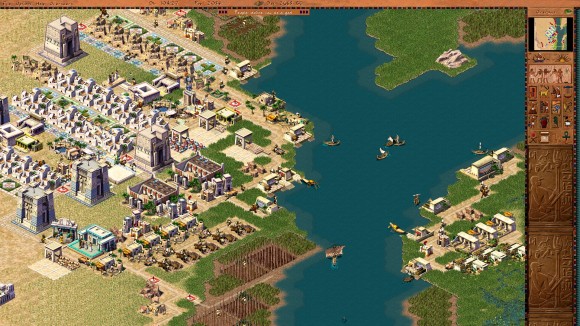
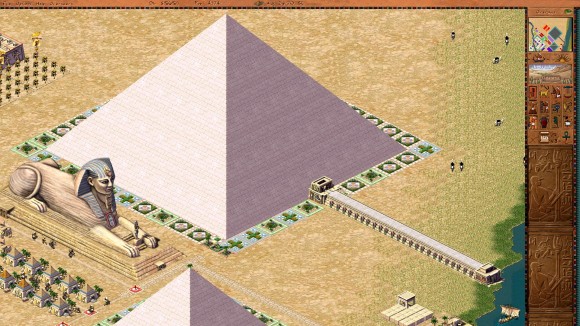
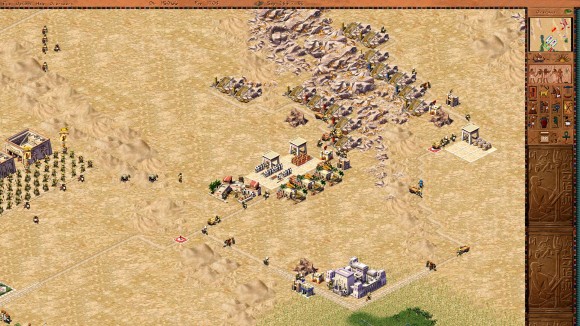
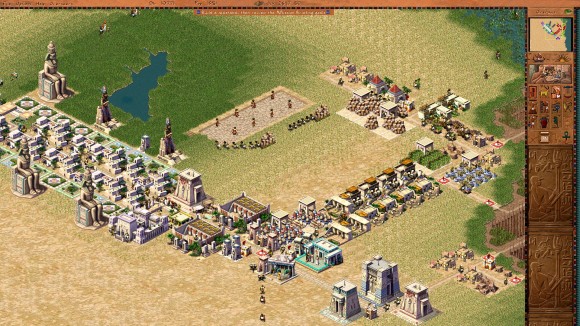
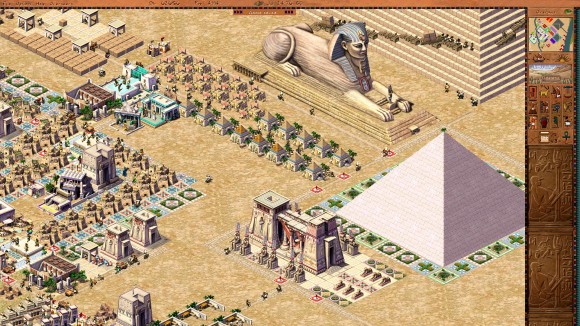
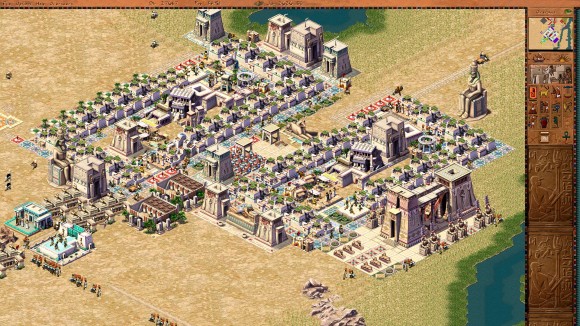
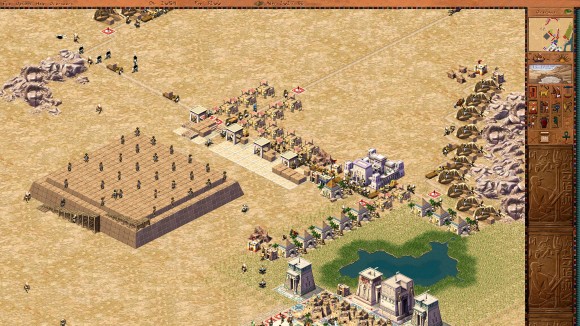
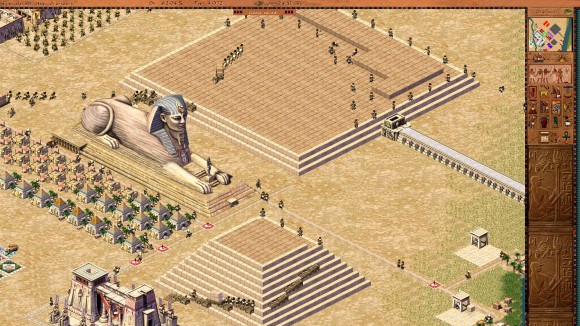
I’ve never played this series, but I keep seeing retrospectives like this that make me think I should change that. It kind of sounds like Anno but without the annoying RTS layer bolted on.
I’m going to throw out Grand Ages: Rome as a suggestion for another game in this rather small genre to look into. It actually handled the military stuff well, and it had an interesting way of modeling resources.
The Anno games are okay, but I’ve never liked the whole island gameplay aspect of it — just let me build one big city, dammit! The City Builder games do unfortunately also have some light RTS elements; they’re not obnoxious, but they are so simple that I wonder why they’re in the game.
Thanks for the Grand Ages: Rome recommendation – I’ll put it on my list of games to maybe look into in the future, although I’ve got two more Impressions games to play first!
I have two issues with Anno:
1) I don’t like the military element. Not because I’m strictly against it in principle, but just because doesn’t mesh well with the rest of the systems
2) It just doesn’t provide enough information about your supply chains. I don’t mind the island setup at all, but I find it much harder to manage because I never know exactly how well I’m doing until protests derail all my progress.
You touch upon important thing we lost with detailed 3D: strategy games have devolved in terms of readability. When you play a modern strategy game like Civilization or Total War you’re never supposed to look at actual models and the map, it’s all there just for zoomedhin screenshots. You have to look at the icon overlay. Strategy games were never meant to look more complex graphically than WarCraft 3, I say.
It’s also sad to me that Impression Games are dead! I’ve only played Emperor for a while and it’s a solid game. The idea of this series was great. I don’t want to talk elitist BS and blame mainstream for ruining videogames, but back then fewer popular games had a pitch that was different from a movie pitch and transported you into some other place. A series about delving into various periods, strange to imagine that today we only have Assassins Creed to scratch that itch (also short-lived expeditions).
And by Rah, what the hell is this remake art style. It looks like those fake mobile game ads.
I blame Supreme Commander, honestly. It was a mediocre game, but Strategic Zoom was so good that everything started using it, which meant that everything had icons, which meant that sooner or later readability would start to be sacrificed because “if they don’t know what it is there’s an icon right there, look”. Readability is one thing I won’t criticise Firaxis for (their UI design, on the other hand…), but Total War *definitely* has a big problem with this that’s even come through in the latest Warhammer game.
And I don’t think mainstream has ruined videogames directly, but I do think that the middle has been squeezed out of the market. The studios who are best equipped to find a historical niche like Impressions did and sit in it for a while have all been bought up by bigger publishers; I’d really struggle to name an AA-level studio (think Obsidian or inXile) that hasn’t featured as part of an acquisition headline in the last three years, and I think that’s going to lead to even less variety in the long-term.
I’ve barely heard about this game but now I’m really interested in trying it. Considering its age, have you had any problems running it on a modern system?
Zero problems running the base game, but you need a special fanpatched widescreen .exe if you want it at modern resolutions. This was harder to find that I would have liked, however a bit of googling turned up a helpful post on the Steam forums pointed me towards a resizer .exe that did the trick: https://steamcommunity.com/app/564530/discussions/0/154643795212940044/?ctp=4#c3186861366075430613
I’ve not played Emperor very much, but Zeus at least does include monuments quite similar to Pharaoh, only not pyramids (obviously) but great big temples to the gods. IIRC, they take somewhat fewer resources to build (in terms of raw quantity), but that’s likely because, while the pyramids in Pharaoh are “merely” mission objectives, the temples in Zeus are more often means to an end, because they let you summon the god in question, or a hero (who can then kill a mythological beast that’s blocking access to some part of the map), or simply gives you access to a resource you can’t otherwise get – off the top of my head, the temple of Athena has an olive grove attached, which is useful if the map doesn’t let you grow them otherwise.
All in all, I remember it as a very solid successor to Pharaoh. I’d absolutely recommend trying it in spite of your dislike of the art style.
Dipping back into Pharaoh for the first time in several years without having played any other city builders recently has really whetted my appetite, and I know that Zeus has a pretty good reputation (if not as good as Pharaoh’s). I do like Greek mythology and am very interested in a game which does more with the religion side than the treatment in Caesar and Pharaoh, so if I don’t go with Nebuchenezzar I might try and get over myself and play a few missions of Zeus instead.
Another spiritual successor was Lethis, set in a steampunk victorian England. Lethis also got a lukewarm reception. After playing around with an idea of Lethis 2 for years that team got contracted to do a remaster of Pharaoh. Caesar 3 was my first video game and I love it to death. Pharaoh was terrific. But it all starts to blend together. The problem for Lethis and Nebuchadezzar is the same as it was for the original Impressions series. By the time Zeus and Emperor rolled around, you really started to feel that they were shipping the same game every year. In a way Caesar 3 has the most longevity out of these games precisely because of the absence of roadblocks or arcane mechanics like population age. They’re annoying from a gameplay perspective, but every city with roadblocks is the same city, whereas Caesar 3 has a built in spontaneity where a walker decides to lose their god damn mind three times in a row and suddenly you have a stability crisis that you have to handle and helps keep you engaged.
I don’t disagree that the yearly release cadence hurt them a little bit — how much can you really iterate when you only have 12 months to make a game? I’ll have to actually play Zeus and Emperor to see if the housing strats transfer across, though; I’ll be disappointed if I can lift and drop what I’ve learned on my Pharaoh playthrough with no adjustment.
Hey, thanks for the nice write up. One correction to your first footnote: Impressions closed AFTER I (the designer of Pharaoh) and most of the team left.
Hey! It’s always slightly unreal when one of the names in the back of the game manuals I spent hours poring over as a kid shows up on here, but I should take the opportunity to thank you for a lot of fun had over the years with various Impressions games. Glad you read the post, and I hope it balances out the drive-by diss on Caesar 4, a game I admittedly haven’t played for very long.
Etched into my memory is the following line from this game: To the marsh we march for the reeds we need.
Yes, there’s a fair bit of subtle humour in both the writing and the voice acting for the various citizens that did make me smile.
Looking at your screenshot, your religious problem appears to stem from lack of shrines. You still need walker coverage from temples to enable housing growth, but pleasing the gods is a separate mechanic that requires a certain amount of religious facilities in your city for a given population. If I remember correctly each shrine provides 1/3rd as much religious “supply” (for lack of a better word) as one temple, but they require no workers and provide a beautification effect to boot. Consequently you only end up needing one temple per housing block but will have an abundance of shrines everywhere.
I forgot to mention that this religious “coverage” requirement is referred to in a single tutorial scroll in one of the early missions in the campaign, which means that it’s easy to forget, misunderstand, or miss altogether in the tutorial information dumps.
Ahhhh, I just assumed that temples were better and only put in shrines in the tiny one-space blocks where I couldn’t put anything else. If they’re that powerful then you’re right, I should have been building a lot more.
That is an astute observation! In the past, I never used shrines, but now I use them all the time. Thank you so much for sharing that. Shrines are so much cheaper, smaller, more cost-effective, etc. And they don’t take up valuable workforce labor! I never have upset deities in the game now that I just slap shrines in all the small spots , e.g., behind architect posts and firehouses, and next to natural obstacles.
Haven’t gotten around to playing this yet but I just saw that a remaster of it has been released. Would be interesting to hear your thoughts about that one as well if/when you try it so that I know which version I should be going for.